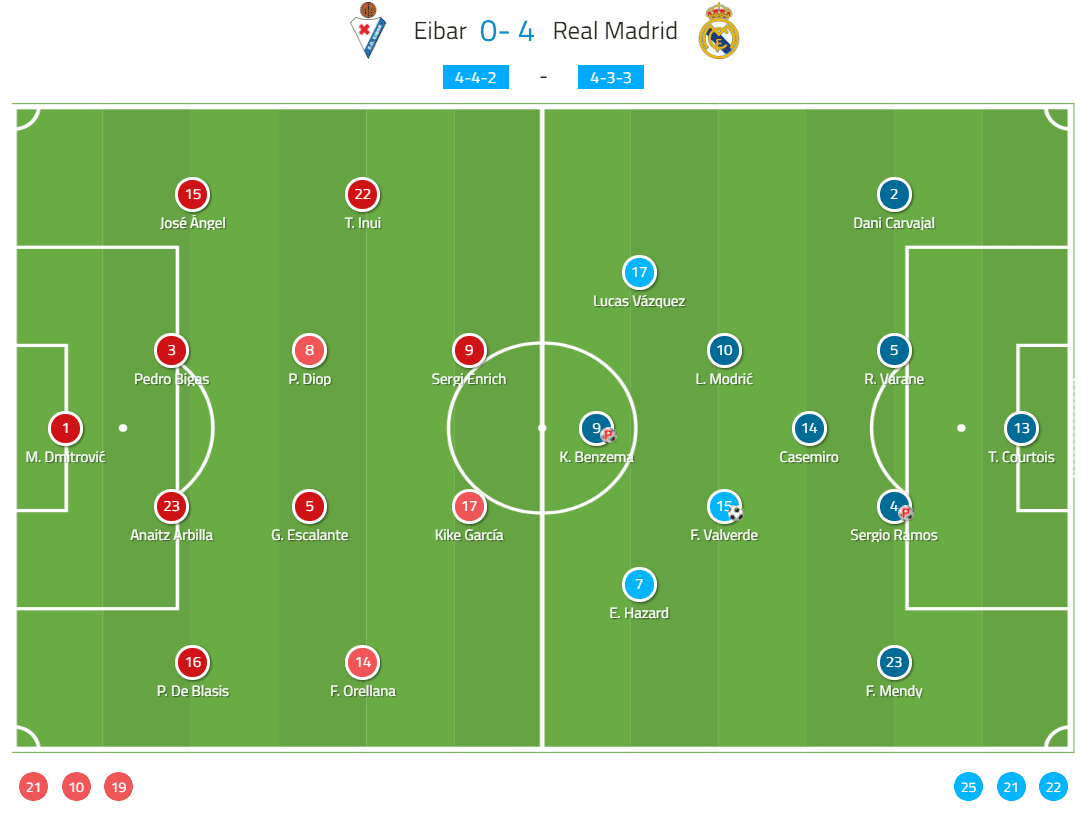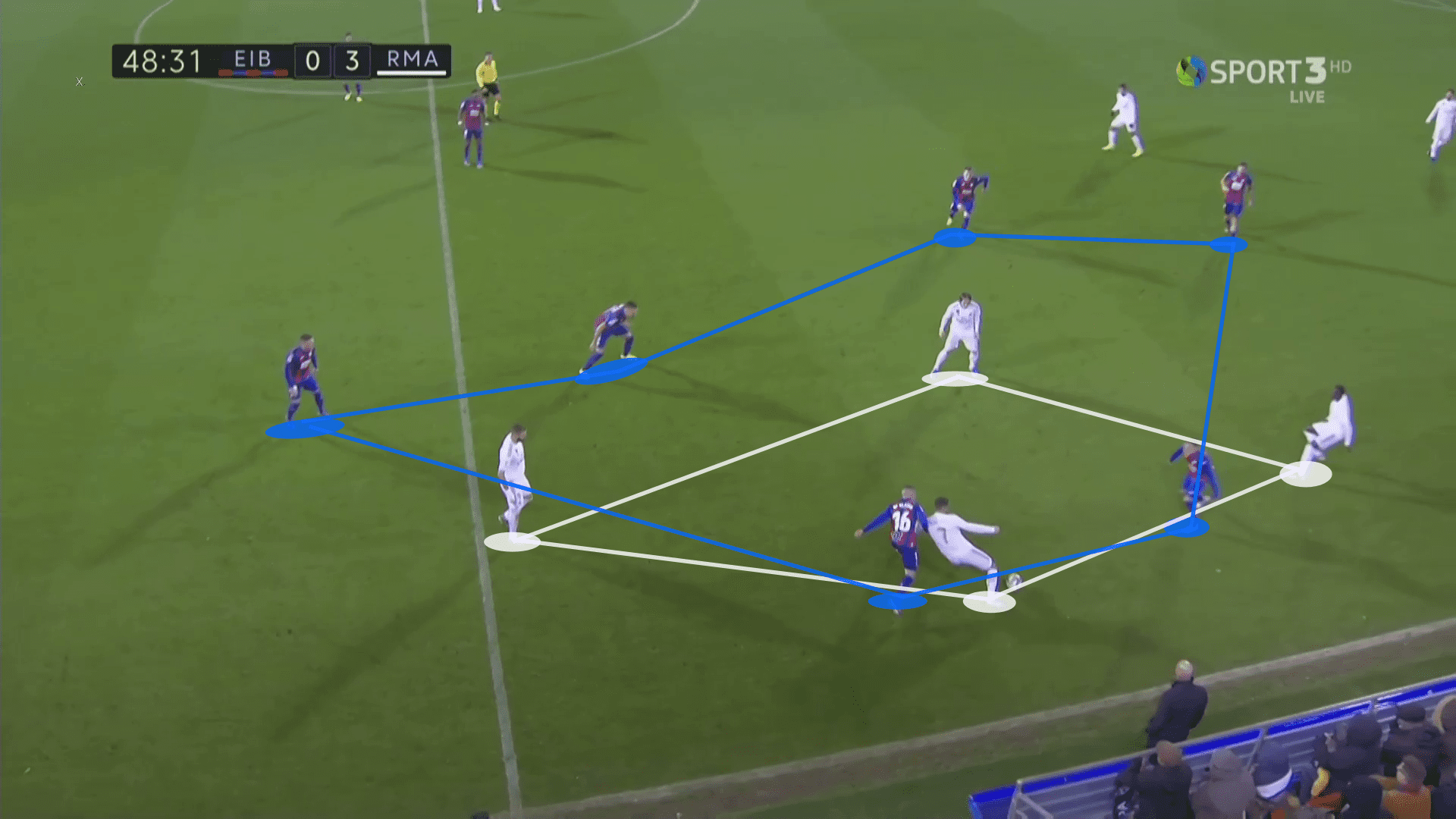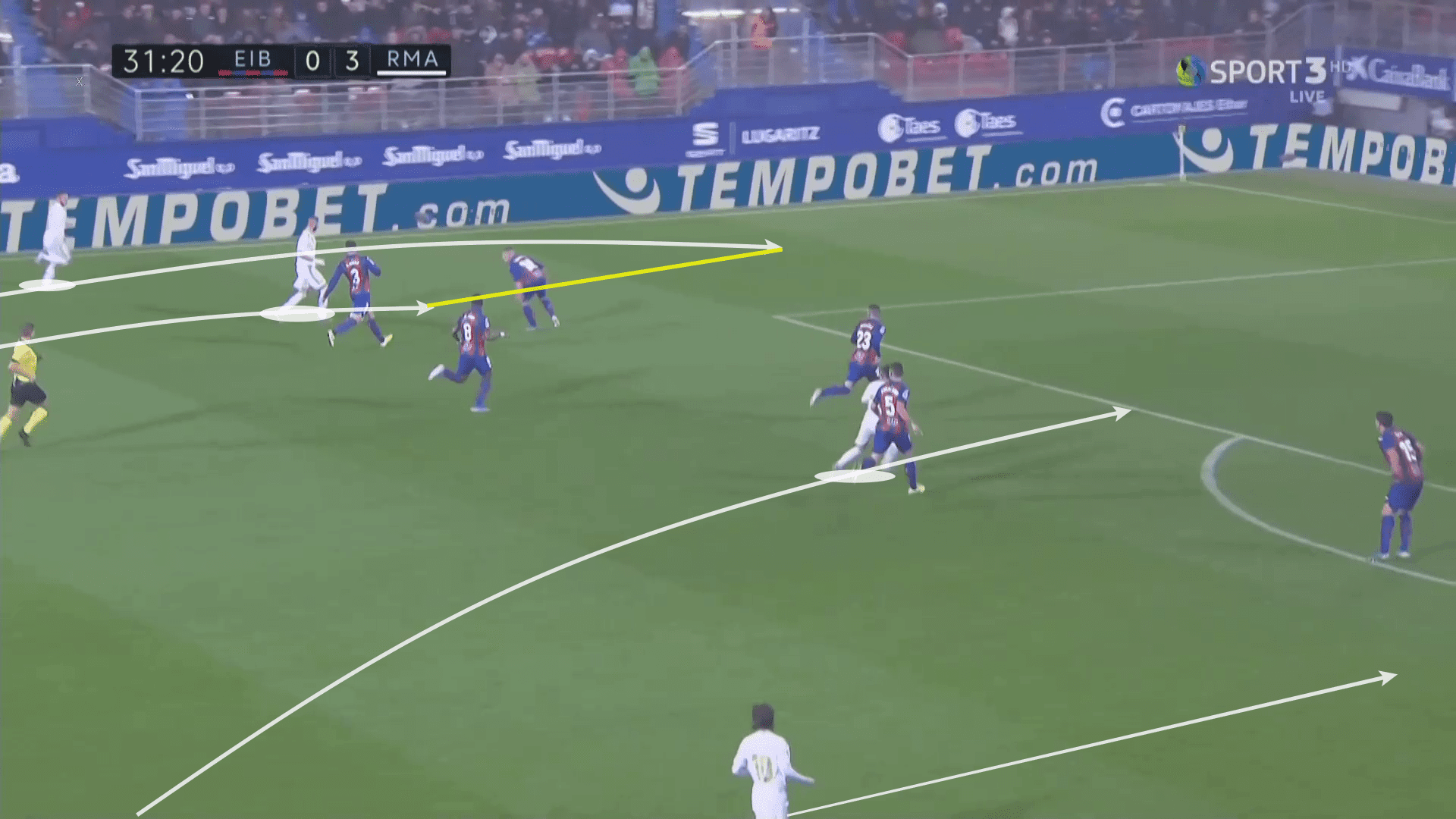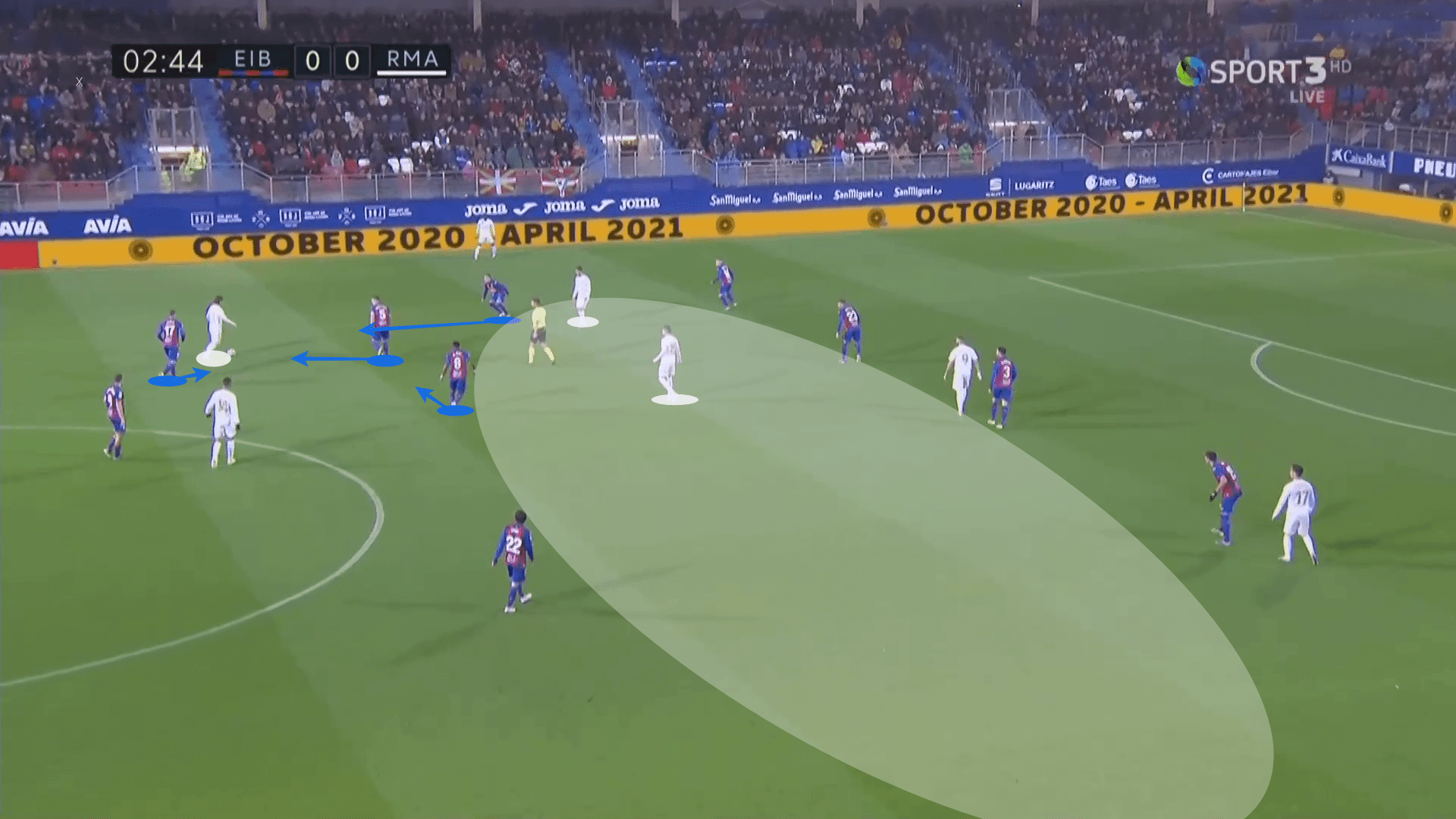Fresh from a midweek thrashing of Galatasaray, Real Madrid travelled to the Estadio Municipal de Ipurua brimming with confidence and it showed. Eibar welcomed them knowing that it would be difficult to repeat the heroics of last season’s shock 3-0 thrashing of the giants but hoping for the best.
That dream lasted only a few minutes. Neat work by Karim Benzema and then a goalmouth scramble allowed the Frenchman to get on the end of the rebound to convert and break the deadlock after only a few minutes. Sergio Ramos then added a penalty, with Benzema scoring a second from 12 yards himself as Real Madrid put the tie to bed from the spot. Fede Valverde scored his first goal for the club to make it four with a powerful effort from distance.
This tactical analysis will consider what both Zinedine Zidane and José Luis Mendilibar can learn from the game, as Real Madrid secured a convincing La Liga win over Eibar. This analysis will look at the tactics of both sides, supported by statistics.
Line-ups

Mendilibar made two changes to his team, with Paulo Olivera being replaced by Pedro Bigas in defence and Sergi Enrich bringing a more battle-ready alternative to Charles in attack, sticking to the regular 4-4-2 shape that Mendilibar so regularly relies on.
Zidane made changes of his own, with Ferland Mendy an enforced change replacing the injured Marcelo. Elsewhere, Luka Modrić replaced the rested Toni Kroos whilst Lucas Vázquez also came in for Rodrygo Goes, who scored a hat-trick in midweek but lost his place for this fixture.
Playing out of Eibar’s press
Eibar are La Liga’s leading team in terms of pressing, but Real Madrid found the perfect way around it. Whilst their season average for recoveries, usually one of the best measures of tracking a press, is 93, against Real Madrid they achieved only 75 in one of their lowest returns of the season. That was not for want of trying, as Mendilibar instructed his team to press high and engage with Real Madrid players in their own half, looking to cut off attacks at the source rather than taking the approach which worked so well for Real Betis last weekend, sitting deep and defending in an organised structure.
Real Madrid played around it in a style which was similar to the one used by Barcelona at the peak of tiki-taka. Each player on the ball would instantly be surrounded by three team-mates looking to make a diamond within a small space, not looking to spread out or provide a long ball option, but rather providing short passing options to quickly move the ball on in one or two touches. As this example shows below, Hazard’s quick passing helped to effectively take out six players from the game with Modrić and Mendy turning the high-pressure situation into a counter-attack.

What was even more intriguing was the way that Real Madrid did not fear putting themselves on the front foot, pressing high themselves to take on Eibar. In total, they recorded 91 recoveries, a figure they’ve beaten just once all season. Such energy and intensity are just what Zidane has been demanding of his team since he arrived in March, but they have only just begun to show. With results now coming, rotations allowing his players to maintain this intensity and confidence growing, there are reasons to be optimistic.
Left-wing overload
Madrid stood out on Saturday for the way in which they attacked in just how much freedom Benzema had. Typically, he will drop deep and occasionally wide, but will most frequently be found in a central area. On Saturday, that was not the case. Benzema spent much of his time drifting wide, usually to the left. This was essential as it removed him from Eibar’s crowded central area, where their two central midfielders sat deep. It also allowed him to combine with the wide man, primarily Eden Hazard on the left, to create an even more dangerous threat, as was the case for the first goal.
His link-up play with Hazard was particularly impressive as he would drift wide, particularly on the counter, with Hazard then providing an overlapping run to compensate for the difference between Mendy and Marcelo, with the French left-back not as offensive as the Brazilian. Still, with this connection with Hazard, half of Real Madrid’s counter-attacks came down the left, with none of them coming down the right. Eibar took time to adapt to this, meaning that Real Madrid could capitalise effectively with many of their early attacks coming down that side of the pitch.

It also allowed Real Madrid to get men forward in numbers quickly. With Benzema drifting to the left, Vázquez would switch to a more central role, allowing midfield runners like Modrić or Valverde to take up the role on the right, effectively creating a situation where Real Madrid could attack with four on four if they got their runners forward quickly enough. Such a threat was crucial to Real Madrid looking so clinical in attack, something that they have struggled with at times this season.
Modrić back to his best
When players are given a chance after a spell on the bench, it’s essential that they take advantage. In the case of Modrić, he did just that with a performance which provided a flashback to the peak of his career, dominating the midfield battle and providing the perfect combination for Valverde alongside him, proving that the two can play alongside one another and not necessarily instead of each other. However, there was much more to this outing than simply registering his second assist of the season, starting with his fine distribution and passing in midfield.
With 58 passes and 91% accuracy, it was the highest number of passes in a game since April, just going to show the growing influence that Modrić had. It would have been easy for a superstar relegated to the bench to have shirked his responsibilities, or even for his team-mates to not have the same respect for him, particularly with Valverde having taken over many of his roles. That was not the case though, with Modrić looking rejuvenated with more energy to make the daring runs and pick out pinpoint passes as he is used to doing.

Equally, he was key in bringing the ball forwards, completing three dribbles, his highest for a single 90 minutes since March. As he did so, he would time his runs well. He would often look to draw in Eibar players in order to create a pressing situation which would consequentially create space for others elsewhere. Alternating with Valverde in the more offensive midfield role created a sense of unpredictability which created space for Real Madrid and Eibar began to see holes open up in their defensive set-up across the field.
Conclusion
Real Madrid have struggled for consistency, as a 5-0 win over Leganés followed by a 0-0 draw with Real Betis proved, but they finally seem to be gaining momentum. With 19 goals scored in their past four fixtures, including firing a blank in one of them, their free-flowing attacking style is immense. Eibar looked to provide a different test, sticking to what they do best and pressing high with intensity. Had they come up against the Real Madrid of early October, it may well have worked. Unfortunately for Mendilibar and co., Los Blancos have upped their own intensity levels a notch since then and it was that work rate which ultimately made the difference.

If you love tactical analysis, then you’ll love the digital magazines from totalfootballanalysis.com – a guaranteed 100+ pages of pure tactical analysis covering topics from the Premier League, Serie A, La Liga, Bundesliga and many, many more. Buy your copy of the November issue for just ₤4.99 here





Comments